2023 SUBARU SOLTERRA service
[x] Cancel search: servicePage 77 of 628
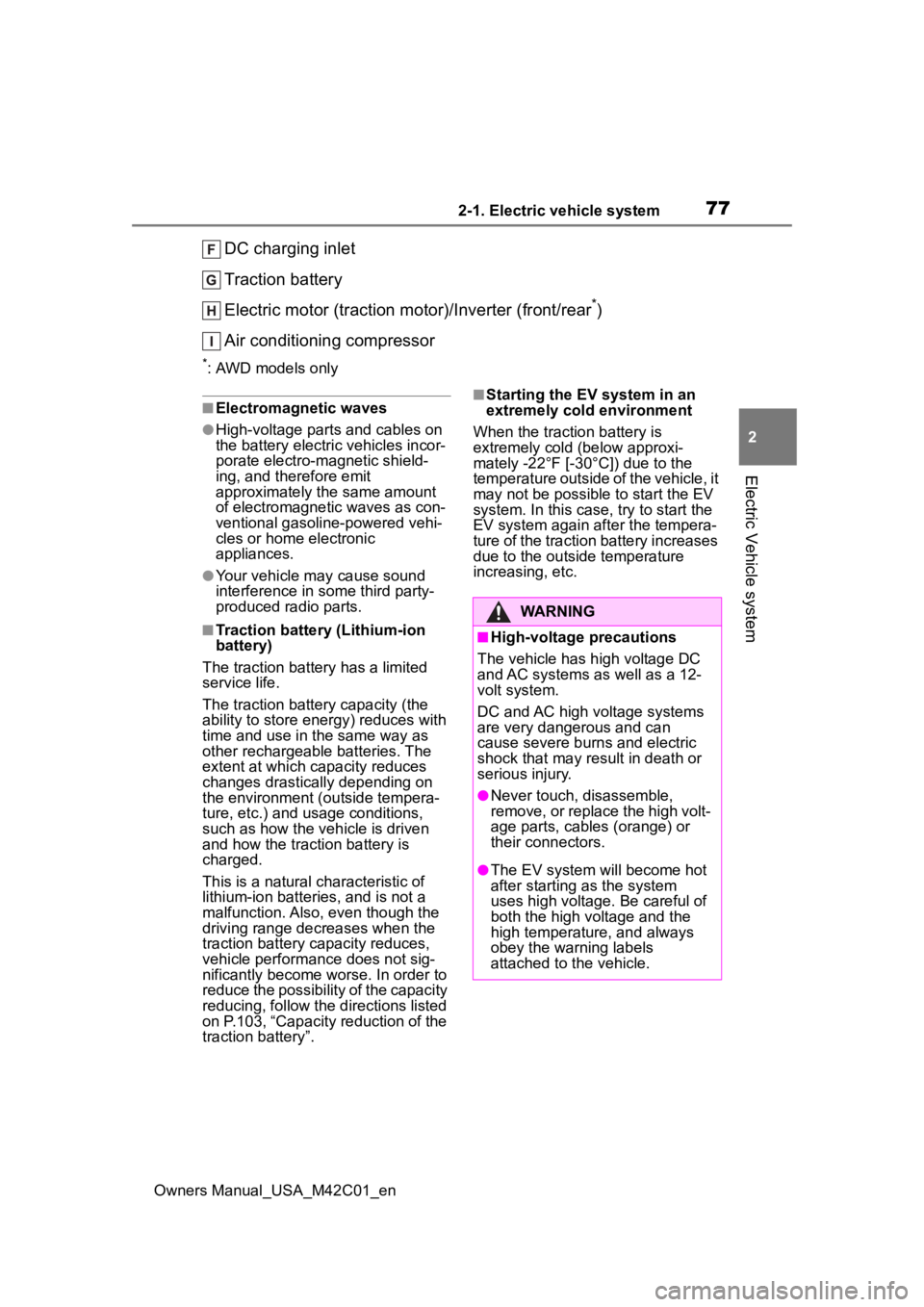
772-1. Electric vehicle system
Owners Manual_USA_M42C01_en
2
Electric Vehicle system
DC charging inlet
Traction battery
Electric motor (traction motor)/Inverter (front/rear
*)
Air conditioning compressor
*: AWD models only
■Electromagnetic waves
●High-voltage parts and cables on
the battery electric vehicles incor-
porate electro-magnetic shield-
ing, and the refore emit
approximately the same amount
of electromagnetic waves as con-
ventional gasoli ne-powered vehi-
cles or home electronic
appliances.
●Your vehicle may cause sound
interference in so me third party-
produced radio parts.
■Traction battery (Lithium-ion
battery)
The traction batte ry has a limited
service life.
The traction battery capacity (the
ability to store ene rgy) reduces with
time and use in the same way as
other rechargeable batteries. The
extent at which capacity reduces
changes drastically depending on
the environment (outside tempera-
ture, etc.) and us age conditions,
such as how the vehicle is driven
and how the traction battery is
charged.
This is a natural characteristic of
lithium-ion batteries, and is not a
malfunction. Also, even though the
driving range decreases when the
traction battery capacity reduces,
vehicle performance does not sig-
nificantly become worse. In order to
reduce the possibility of the capacity
reducing, follow the directions listed
on P.103, “Capacity reduction of the
traction battery”.
■Starting the EV system in an
extremely cold environment
When the traction battery is
extremely cold (below approxi-
mately -22°F [-30°C]) due to the
temperature outside of the vehicle, it
may not be possible to start the EV
system. In this case, try to start the
EV system again after the tempera-
ture of the traction battery increases
due to the outside temperature
increasing, etc.
WARNING
■High-voltage precautions
The vehicle has high voltage DC
and AC systems as well as a 12-
volt system.
DC and AC high voltage systems
are very dangerous and can
cause severe burns and electric
shock that may result in death or
serious injury.
●Never touch, disassemble,
remove, or replace the high volt-
age parts, cables (orange) or
their connectors.
●The EV system will become hot
after starting as the system
uses high voltage. Be careful of
both the high voltage and the
high temperature, and always
obey the warning labels
attached to the vehicle.
Page 78 of 628
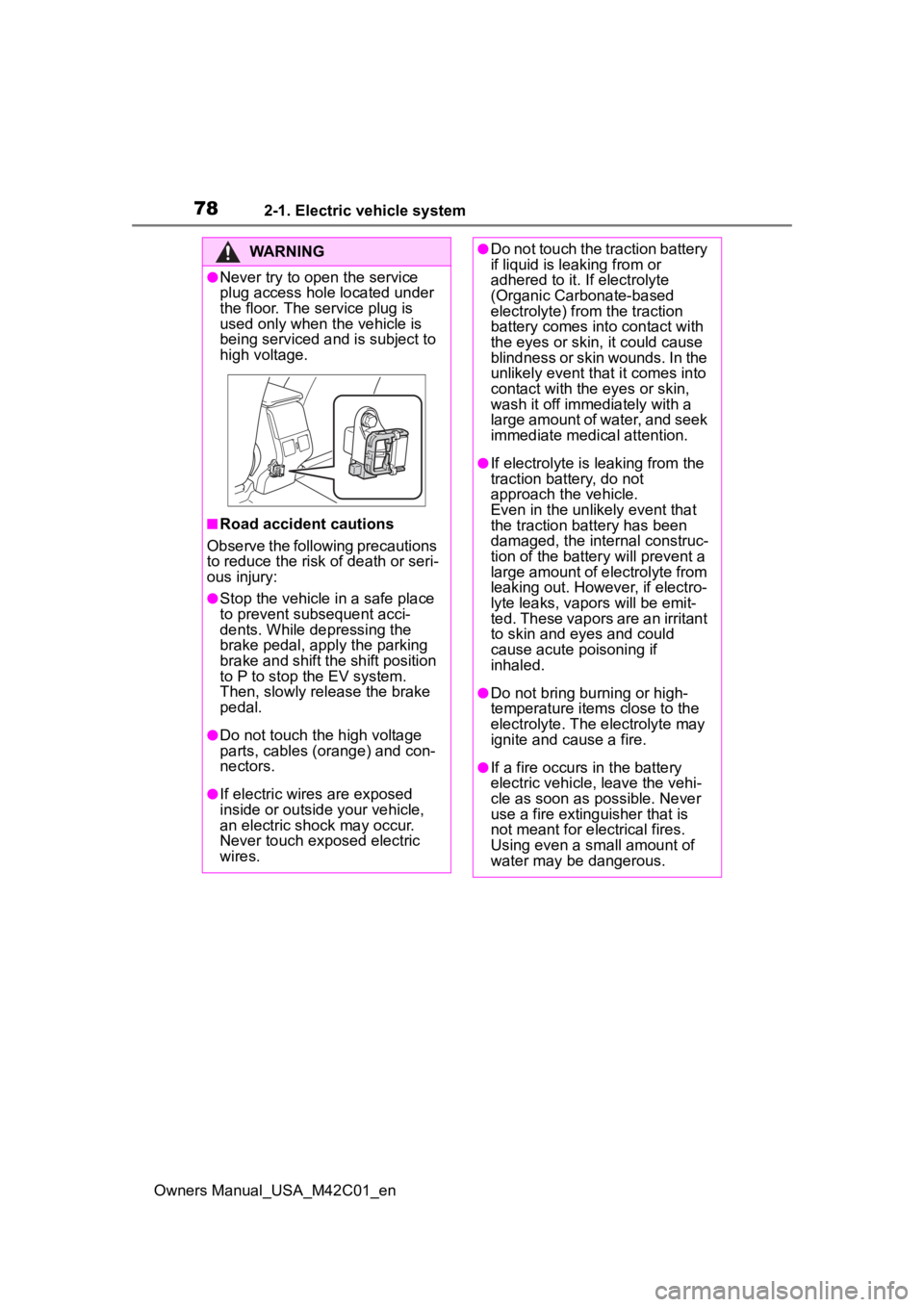
782-1. Electric vehicle system
Owners Manual_USA_M42C01_en
WARNING
●Never try to open the service
plug access hole located under
the floor. The service plug is
used only when the vehicle is
being serviced and is subject to
high voltage.
■Road accident cautions
Observe the following precautions
to reduce the risk of death or seri-
ous injury:
●Stop the vehicle i n a safe place
to prevent subsequent acci-
dents. While depressing the
brake pedal, apply the parking
brake and shift the shift position
to P to stop the EV system.
Then, slowly release the brake
pedal.
●Do not touch the high voltage
parts, cables (orange) and con-
nectors.
●If electric wires are exposed
inside or outside your vehicle,
an electric shock may occur.
Never touch exposed electric
wires.
●Do not touch the traction battery
if liquid is leaking from or
adhered to it. If electrolyte
(Organic Carbonate-based
electrolyte) from the traction
battery comes into contact with
the eyes or skin, it could cause
blindness or skin wounds. In the
unlikely event that it comes into
contact with the eyes or skin,
wash it off immediately with a
large amount of water, and seek
immediate medical attention.
●If electrolyte is leaking from the
traction battery, do not
approach the vehicle.
Even in the unlikely event that
the traction battery has been
damaged, the internal construc-
tion of the batter y will prevent a
large amount of electrolyte from
leaking out. However, if electro-
lyte leaks, vapors will be emit-
ted. These vapors are an irritant
to skin and eyes and could
cause acute poisoning if
inhaled.
●Do not bring burning or high-
temperature items close to the
electrolyte. The electrolyte may
ignite and cause a fire.
●If a fire occurs in the battery
electric vehicle, leave the vehi-
cle as soon as possible. Never
use a fire extinguisher that is
not meant for electrical fires.
Using even a small amount of
water may be dangerous.
Page 79 of 628
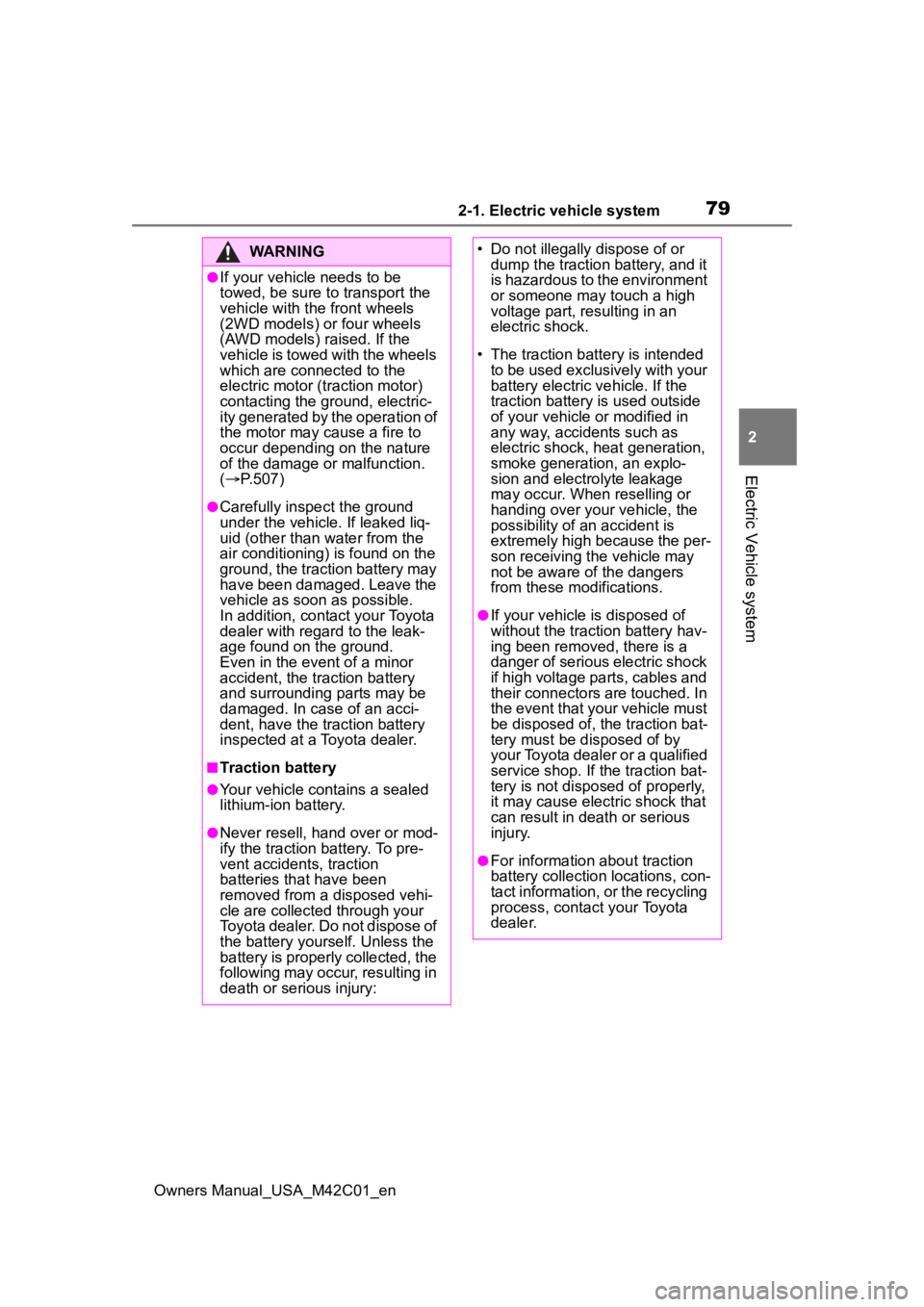
792-1. Electric vehicle system
Owners Manual_USA_M42C01_en
2
Electric Vehicle system
WARNING
●If your vehicle needs to be
towed, be sure to transport the
vehicle with the front wheels
(2WD models) or four wheels
(AWD models) raised. If the
vehicle is towed with the wheels
which are connected to the
electric motor (traction motor)
contacting the ground, electric-
ity generated by the operation of
the motor may cause a fire to
occur depending on the nature
of the damage or malfunction.
( P.507)
●Carefully inspect the ground
under the vehicle. If leaked liq-
uid (other than water from the
air conditioning) is found on the
ground, the traction battery may
have been damaged. Leave the
vehicle as soon as possible.
In addition, contact your Toyota
dealer with regard to the leak-
age found on the ground.
Even in the event of a minor
accident, the traction battery
and surrounding parts may be
damaged. In case of an acci-
dent, have the traction battery
inspected at a Toyota dealer.
■Traction battery
●Your vehicle contains a sealed
lithium-ion battery.
●Never resell, hand over or mod-
ify the traction battery. To pre-
vent accidents, traction
batteries that have been
removed from a disposed vehi-
cle are collected through your
Toyota dealer. Do not dispose of
the battery yourself. Unless the
battery is properly collected, the
following may occur, resulting in
death or serious injury:
• Do not illegally dispose of or
dump the traction battery, and it
is hazardous to the environment
or someone may touch a high
voltage part, resulting in an
electric shock.
• The traction battery is intended to be used exclusively with your
battery electric vehicle. If the
traction battery is used outside
of your vehicle or modified in
any way, accidents such as
electric shock, heat generation,
smoke generation, an explo-
sion and electrolyte leakage
may occur. When reselling or
handing over your vehicle, the
possibility of an accident is
extremely high because the per-
son receiving the vehicle may
not be aware of the dangers
from these modifications.
●If your vehicle is disposed of
without the traction battery hav-
ing been removed, there is a
danger of serious electric shock
if high voltage parts, cables and
their connectors are touched. In
the event that your vehicle must
be disposed of, the traction bat-
tery must be disposed of by
your Toyota dealer or a qualified
service shop. If the traction bat-
tery is not disposed of properly,
it may cause electric shock that
can result in dea th or serious
injury.
●For information about traction
battery collection locations, con-
tact information, or the recycling
process, contact your Toyota
dealer.
Page 120 of 628

1202-2. Charging
Owners Manual_USA_M42C01_enschedule, connect the AC
charging connector
The charging start time is deter-
mined based on the charging
schedule at the t ime that the AC
charging connector was connected.
●Connect the AC charging connec-
tor before the start time
When the charging mode is set to
“Start”, if you connect the AC
charging connector after the set
start time, the next charging sched-
ule will be referenced.
When the charging mode is “Start-
Stop”, if you connect the AC
charging connector after the start
time, charging will start immediately
and charging will be performed until
the stop time.
●After connecting the AC charging
connector, check that the charging
indicator of the charging port
flashes ( P. 8 6 )
●Do not use an ou tlet that has a
power cut off function (including a
timer function)
Use an outlet that constantly sup-
plies electricity. For outlets where
the power is cut off due to a timer
function, etc., charging may not be
carried out accord ing to plan if the
power is cut off during the set time.
■When the AC charging connec-
tor remains connected to the
vehicle
●When the charging mode is set to
“Start”, even if multiple consecu-
tive charging schedules are regis-
tered, the next charge will not be
carried out according to the
charging schedule until the AC
charging connector is removed
and reconnected after charging
completes. Also, when the traction
battery is fully charged, charging
according to the charging sched- ule will not be carried out.
●If the charging stop time is
reached before t
he traction bat-
tery is fully cha rged and the
charging mode is set to “Start-
Stop”, the nearest charging
schedule after the stop time is
updated as the next charging
schedule, and charging is
repeated until the battery is fully
charged.
■Smartphone-linked operation
After applying to Toyota App, it is
possible to use the smartphone
application to change charging
schedule settings.
For details about Toyota Apps, refer
to http://www.toyota.com/
connected-services in the United
States and http://www.toy-
ota.ca/connected in Canada.
■When charging schedules are
ignored
When the following operations are
performed while the charging
schedule is on standby, charging
schedule is temporarily canceled
and charging is started.
●When the Remote Air Condition-
ing System ( P.409) is operated
●When turning “My Room Mode”
on ( P.129)
●When turning “Charge Now” on
( P.124, 128)
●When an operation that temporar-
ily cancel charging using the
charging schedule ( P.107)
■Battery heater ( P.99)/“Battery
Cooler” ( P. 9 9 )
Depending on the temperature of
the traction battery , the traction bat-
tery heater or traction battery cooler
may be activated and the charging
indicator may light up while the timer
is waiting for charging.
Page 166 of 628

1664-1. Key information
Owners Manual_USA_M42C01_en
key of the vehicle if traveling
to a location with unreliable
communications.
If the smartphone battery is
depleted, the smartphone
cannot be used as Digital Key.
If the battery level is low, be
sure to charge the smart-
phone prior to going out.
The Digital Key system is
related to the Smart key sys-
tem. If the Smart key system
has been deactivated in the
vehicle customization setting,
the Digital Key will also be
disabled.
Depending on the radio wave
environment, the Digital Key
may not be able to be used.
P. 1 8 8
When transferring vehicle
ownership, make sure to
delete the Digital Keys.
If the vehicle is not operated
for 14 days or more, the Digi-
tal Key will not connect auto-
matically. Therefore, it may
take some time before the
system operates after a door
handle is touched.
A part of the services may be
stopped for a certain period of
time due to server mainte-
nance. However, registered
Digital Keys can be used
during the maintenance.
A smartphone with the Digital
Key App enabled will be able to lock and unlock the doors,
start the EV system and per-
form any other operations as
same as the electronic key of
the vehicle. Be especially
careful not to lose the smart-
phone or allow it to be stolen.
If the smartphone is lost or
stolen, contact your Toyota
dealer immediately.
When taking your vehicle to a
Toyota dealer for an inspec-
tion or repairs, make sure to
bring an electronic key.
Page 257 of 628
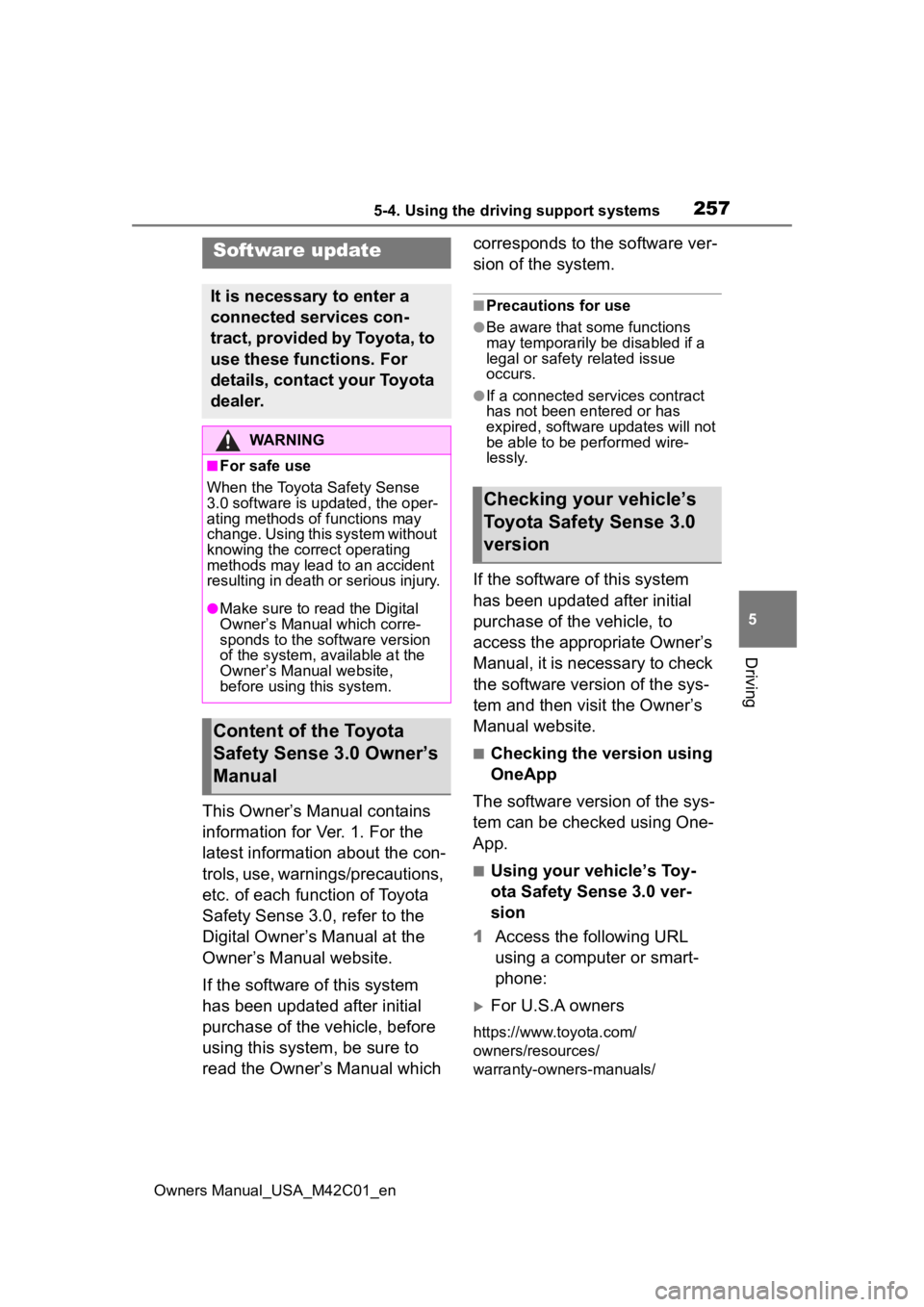
2575-4. Using the driving support systems
Owners Manual_USA_M42C01_en
5
Driving
5-4.Using the driving support systems
This Owner’s Manual contains
information for Ver. 1. For the
latest information about the con-
trols, use, warnings/precautions,
etc. of each function of Toyota
Safety Sense 3.0, refer to the
Digital Owner’s Manual at the
Owner’s Manual website.
If the software of this system
has been updated after initial
purchase of the vehicle, before
using this system, be sure to
read the Owner’s Manual which corresponds to the software ver-
sion of the system.
■Precautions for use
●Be aware that some functions
may temporarily be disabled if a
legal or safety related issue
occurs.
●If a connected services contract
has not been entered or has
expired, software updates will not
be able to be performed wire-
lessly.
If the software of this system
has been updated after initial
purchase of the vehicle, to
access the appropriate Owner’s
Manual, it is necessary to check
the software version of the sys-
tem and then visit the Owner’s
Manual website.
■Checking the version using
OneApp
The software version of the sys-
tem can be checked using One-
App.
■Using your vehicle’s Toy-
ota Safety Sense 3.0 ver-
sion
1 Access the following URL
using a computer or smart-
phone:
For U.S.A owners
https://www.toyota.com/
owners/resources/
warranty-owners-manuals/
Software update
It is necessary to enter a
connected services con-
tract, provided by Toyota, to
use these functions. For
details, contact your Toyota
dealer.
WARNING
■For safe use
When the Toyota Safety Sense
3.0 software is updated, the oper-
ating methods of functions may
change. Using this system without
knowing the correct operating
methods may lead to an accident
resulting in death or serious injury.
●Make sure to read the Digital
Owner’s Manual which corre-
sponds to the software version
of the system, available at the
Owner’s Manual website,
before using this system.
Content of the Toyota
Safety Sense 3.0 Owner’s
Manual
Checking your vehicle’s
Toyota Safety Sense 3.0
version
Page 393 of 628

3935-5. Driving tips
Owners Manual_USA_M42C01_en
5
Driving
5-5.Driving tips
Use fluids that are appropriate
to the prevailing outside tem-
peratures.
• Power control unit coolant
• Heater coolant
• Washer fluid
Have a service technician
inspect the condition of the
12-volt battery.
Have the vehicle fitted with
four snow tires or purchase a
set of tire chains for the front
tires.
Ensure that all tires are the same
size and brand, and that chains
match the size of the tires.
Perform the following according
Winter driving tips
Carry out the necessary
preparations and inspec-
tions before driving the
vehicle in winter. Always
drive the vehicle in a man-
ner appropriate to the pre-
vailing weather conditions.
Pre-winter preparations
WARNING
■Driving with snow tires
Observe the following precautions
to reduce the risk of accidents.
Failure to do so m ay result in a
loss of vehicle control and cause
death or serious injury.
●Use tires of the specified size.
●Maintain the recommended
level of air pressure.
●Do not drive in excess of 75
mph (120 km/h), regardless of
the type of snow tires being
used.
●Use snow tires on all, not just
some wheels.
■Driving with tire chains
Observe the following precautions
to reduce the risk of accidents.
Failure to do so may result in the
vehicle being unable to be driven
safely, and may cause death or
serious injury.
●Do not drive in excess of the
speed limit specifi ed for the tire
chains being used, or 30 mph
(50 km/h), whichever is lower.
●Avoid driving on bumpy road
surfaces or over potholes.
●Avoid sudden acceleration,
abrupt steering, sudden brak-
ing and shifting operations that
cause sudden regenerative
braking.
●Slow down sufficiently before
entering a curve to ensure that
vehicle control is maintained.
●Do not use LTA (Lane Tracing
Assist).
NOTICE
■Repairing or replacing snow
tires
Request repairs or replacement of
snow tires from your Toyota
dealer or legitimate tire retailers.
This is because the removal and
attachment of snow tires affects
the operation of the tire pressure
warning valves and transmitters.
Before driving the vehicle
Page 397 of 628
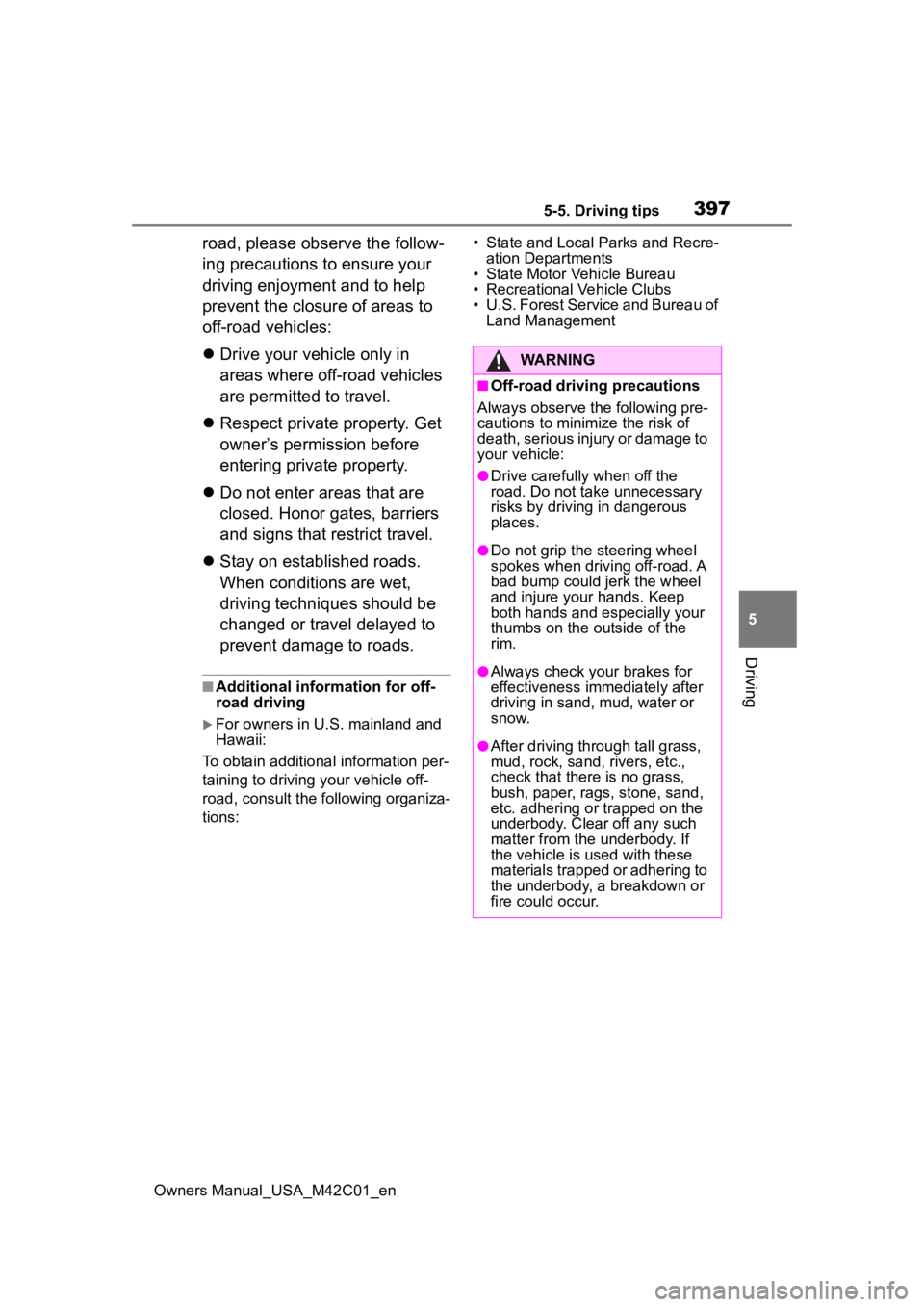
3975-5. Driving tips
Owners Manual_USA_M42C01_en
5
Driving
road, please observe the follow-
ing precautions to ensure your
driving enjoyment and to help
prevent the closure of areas to
off-road vehicles:
Drive your vehicle only in
areas where off-road vehicles
are permitted to travel.
Respect private property. Get
owner’s permission before
entering private property.
Do not enter areas that are
closed. Honor gates, barriers
and signs that restrict travel.
Stay on established roads.
When conditions are wet,
driving techniques should be
changed or travel delayed to
prevent damage to roads.
■Additional information for off-
road driving
For owners in U.S. mainland and
Hawaii:
To obtain additional information per-
taining to driving your vehicle off-
road, consult the following organiza-
tions: • State and Local Parks and Recre-
ation Departments
• State Motor Vehicle Bureau
• Recreational Vehicle Clubs
• U.S. Forest Service and Bureau of Land Management
WARNING
■Off-road driving precautions
Always observe t he following pre-
cautions to minim ize the risk of
death, serious injury or damage to
your vehicle:
●Drive carefully when off the
road. Do not take unnecessary
risks by driving in dangerous
places.
●Do not grip the steering wheel
spokes when driving off-road. A
bad bump could jerk the wheel
and injure your hands. Keep
both hands and especially your
thumbs on the ou tside of the
rim.
●Always check your brakes for
effectiveness immediately after
driving in sand, mud, water or
snow.
●After driving through tall grass,
mud, rock, sand, rivers, etc.,
check that there is no grass,
bush, paper, rags, stone, sand,
etc. adhering or trapped on the
underbody. Clear off any such
matter from the underbody. If
the vehicle is used with these
materials trapped or adhering to
the underbody, a breakdown or
fire could occur.